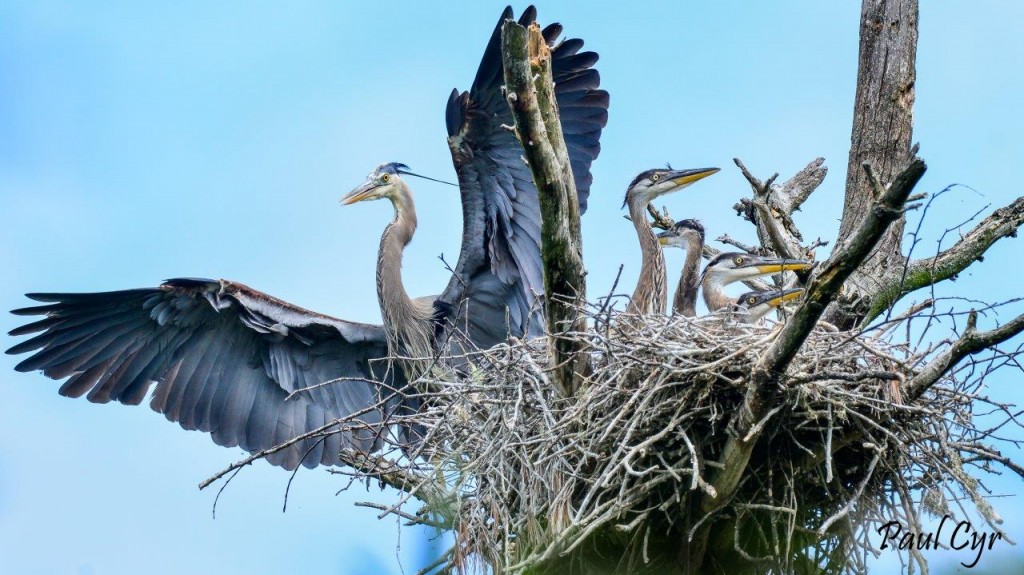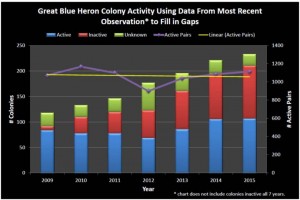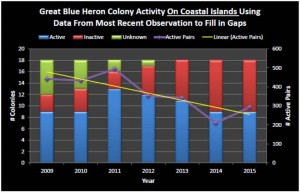December 15, 2015 at 12:56 pm
[caption id="attachment_1318" align="aligncenter" width="1024"] Great blue heron nest discovered and photographed by Paul Cyr.[/caption]
This past spring while I was focused on completing an extensive aerial survey effort to estimate the statewide breeding population of great blue herons, 76 Heron Observation Network volunteers quietly continued their important work. For seven years now, these citizen scientists have visited great blue heron colonies across the state to document nesting activity, including the number of active nests and the number of young produced. These data from the first six years of volunteer surveys fed directly into the design of this year’s dual-frame aerial survey, and the data collected this year and over the next few years will feed into similar aerial survey efforts to determine the population trend.
[caption id="attachment_1321" align="alignleft" width="300"]
Great blue heron nest discovered and photographed by Paul Cyr.[/caption]
This past spring while I was focused on completing an extensive aerial survey effort to estimate the statewide breeding population of great blue herons, 76 Heron Observation Network volunteers quietly continued their important work. For seven years now, these citizen scientists have visited great blue heron colonies across the state to document nesting activity, including the number of active nests and the number of young produced. These data from the first six years of volunteer surveys fed directly into the design of this year’s dual-frame aerial survey, and the data collected this year and over the next few years will feed into similar aerial survey efforts to determine the population trend.
[caption id="attachment_1321" align="alignleft" width="300"] Figure1 shows heron colony activity for 2009 based on direct observations. For years 2010-2015, the data represents direct observations plus the most recent data (collected 2009 or later) for colonies not surveyed that year. Colonies that were inactive all seven years were omitted from this figure. Despite a drop in pairs 2012, the linear trend line indicates the number of nesting pairs somewhat stable with an average of 87 colonies with 1,068 nesting pairs at each year. (Click to enlarge.)[/caption]
Monitoring Maine’s nesting great blue herons cannot be done without the help of HERON volunteers. With freshwater wetlands covering over five million acres and forest covering approximately 90% of the state, a majority of Maine is considered potential habitat for herons. Within the last seven years, we have observed nesting activity at 233 great blue heron colonies statewide. Not all 233 have ever been active in the same year. Colonies may persist for decades, but they also may blink on and off, or splinter into several small colonies. Data collected by volunteers does not include every heron colony in the state nor does it reflect a random sample of the colonies. However, for sites that were monitored in only some of the last seven years, the latest information for that site may still hold true.
Using the best available data that we have, we can show what we know and realize that the information has limitations. Over the past seven years our data shows a yearly average of 87 active colonies with 1068 nesting pairs for the entire state (Figure 1). Overall, the results point to a relatively stable statewide population. But the data show a declining trend in the coastal breeding population (Figure 2).
[caption id="attachment_1322" align="alignright" width="300"]
Figure1 shows heron colony activity for 2009 based on direct observations. For years 2010-2015, the data represents direct observations plus the most recent data (collected 2009 or later) for colonies not surveyed that year. Colonies that were inactive all seven years were omitted from this figure. Despite a drop in pairs 2012, the linear trend line indicates the number of nesting pairs somewhat stable with an average of 87 colonies with 1,068 nesting pairs at each year. (Click to enlarge.)[/caption]
Monitoring Maine’s nesting great blue herons cannot be done without the help of HERON volunteers. With freshwater wetlands covering over five million acres and forest covering approximately 90% of the state, a majority of Maine is considered potential habitat for herons. Within the last seven years, we have observed nesting activity at 233 great blue heron colonies statewide. Not all 233 have ever been active in the same year. Colonies may persist for decades, but they also may blink on and off, or splinter into several small colonies. Data collected by volunteers does not include every heron colony in the state nor does it reflect a random sample of the colonies. However, for sites that were monitored in only some of the last seven years, the latest information for that site may still hold true.
Using the best available data that we have, we can show what we know and realize that the information has limitations. Over the past seven years our data shows a yearly average of 87 active colonies with 1068 nesting pairs for the entire state (Figure 1). Overall, the results point to a relatively stable statewide population. But the data show a declining trend in the coastal breeding population (Figure 2).
[caption id="attachment_1322" align="alignright" width="300"] Figure 2 shows the same data as Figure 1, but only for the colonies on coastal islands. Despite stable numbers for the statewide population shown in Figure 1, it appears our coastal population may still be declining. (Click to enlarge)[/caption]
This past year’s combined survey effort continued to increase our knowledge of the locations and numbers of breeding pairs of great blue herons across the state. We increased our volunteer membership, discovered new colonies, increased the involvement of MDIFW staff, and continued to document volunteer hours and miles for the purpose of leveraging additional federal funds. Below are some quick stats for the 2015 effort:
Figure 2 shows the same data as Figure 1, but only for the colonies on coastal islands. Despite stable numbers for the statewide population shown in Figure 1, it appears our coastal population may still be declining. (Click to enlarge)[/caption]
This past year’s combined survey effort continued to increase our knowledge of the locations and numbers of breeding pairs of great blue herons across the state. We increased our volunteer membership, discovered new colonies, increased the involvement of MDIFW staff, and continued to document volunteer hours and miles for the purpose of leveraging additional federal funds. Below are some quick stats for the 2015 effort:
 Great blue heron nest discovered and photographed by Paul Cyr.[/caption]
This past spring while I was focused on completing an extensive aerial survey effort to estimate the statewide breeding population of great blue herons, 76 Heron Observation Network volunteers quietly continued their important work. For seven years now, these citizen scientists have visited great blue heron colonies across the state to document nesting activity, including the number of active nests and the number of young produced. These data from the first six years of volunteer surveys fed directly into the design of this year’s dual-frame aerial survey, and the data collected this year and over the next few years will feed into similar aerial survey efforts to determine the population trend.
[caption id="attachment_1321" align="alignleft" width="300"]
Great blue heron nest discovered and photographed by Paul Cyr.[/caption]
This past spring while I was focused on completing an extensive aerial survey effort to estimate the statewide breeding population of great blue herons, 76 Heron Observation Network volunteers quietly continued their important work. For seven years now, these citizen scientists have visited great blue heron colonies across the state to document nesting activity, including the number of active nests and the number of young produced. These data from the first six years of volunteer surveys fed directly into the design of this year’s dual-frame aerial survey, and the data collected this year and over the next few years will feed into similar aerial survey efforts to determine the population trend.
[caption id="attachment_1321" align="alignleft" width="300"] Figure1 shows heron colony activity for 2009 based on direct observations. For years 2010-2015, the data represents direct observations plus the most recent data (collected 2009 or later) for colonies not surveyed that year. Colonies that were inactive all seven years were omitted from this figure. Despite a drop in pairs 2012, the linear trend line indicates the number of nesting pairs somewhat stable with an average of 87 colonies with 1,068 nesting pairs at each year. (Click to enlarge.)[/caption]
Monitoring Maine’s nesting great blue herons cannot be done without the help of HERON volunteers. With freshwater wetlands covering over five million acres and forest covering approximately 90% of the state, a majority of Maine is considered potential habitat for herons. Within the last seven years, we have observed nesting activity at 233 great blue heron colonies statewide. Not all 233 have ever been active in the same year. Colonies may persist for decades, but they also may blink on and off, or splinter into several small colonies. Data collected by volunteers does not include every heron colony in the state nor does it reflect a random sample of the colonies. However, for sites that were monitored in only some of the last seven years, the latest information for that site may still hold true.
Using the best available data that we have, we can show what we know and realize that the information has limitations. Over the past seven years our data shows a yearly average of 87 active colonies with 1068 nesting pairs for the entire state (Figure 1). Overall, the results point to a relatively stable statewide population. But the data show a declining trend in the coastal breeding population (Figure 2).
[caption id="attachment_1322" align="alignright" width="300"]
Figure1 shows heron colony activity for 2009 based on direct observations. For years 2010-2015, the data represents direct observations plus the most recent data (collected 2009 or later) for colonies not surveyed that year. Colonies that were inactive all seven years were omitted from this figure. Despite a drop in pairs 2012, the linear trend line indicates the number of nesting pairs somewhat stable with an average of 87 colonies with 1,068 nesting pairs at each year. (Click to enlarge.)[/caption]
Monitoring Maine’s nesting great blue herons cannot be done without the help of HERON volunteers. With freshwater wetlands covering over five million acres and forest covering approximately 90% of the state, a majority of Maine is considered potential habitat for herons. Within the last seven years, we have observed nesting activity at 233 great blue heron colonies statewide. Not all 233 have ever been active in the same year. Colonies may persist for decades, but they also may blink on and off, or splinter into several small colonies. Data collected by volunteers does not include every heron colony in the state nor does it reflect a random sample of the colonies. However, for sites that were monitored in only some of the last seven years, the latest information for that site may still hold true.
Using the best available data that we have, we can show what we know and realize that the information has limitations. Over the past seven years our data shows a yearly average of 87 active colonies with 1068 nesting pairs for the entire state (Figure 1). Overall, the results point to a relatively stable statewide population. But the data show a declining trend in the coastal breeding population (Figure 2).
[caption id="attachment_1322" align="alignright" width="300"] Figure 2 shows the same data as Figure 1, but only for the colonies on coastal islands. Despite stable numbers for the statewide population shown in Figure 1, it appears our coastal population may still be declining. (Click to enlarge)[/caption]
This past year’s combined survey effort continued to increase our knowledge of the locations and numbers of breeding pairs of great blue herons across the state. We increased our volunteer membership, discovered new colonies, increased the involvement of MDIFW staff, and continued to document volunteer hours and miles for the purpose of leveraging additional federal funds. Below are some quick stats for the 2015 effort:
Figure 2 shows the same data as Figure 1, but only for the colonies on coastal islands. Despite stable numbers for the statewide population shown in Figure 1, it appears our coastal population may still be declining. (Click to enlarge)[/caption]
This past year’s combined survey effort continued to increase our knowledge of the locations and numbers of breeding pairs of great blue herons across the state. We increased our volunteer membership, discovered new colonies, increased the involvement of MDIFW staff, and continued to document volunteer hours and miles for the purpose of leveraging additional federal funds. Below are some quick stats for the 2015 effort:
- HERON grew to 261 volunteer members
- 11 new great blue heron colonies were reported or found since August 2014
- 17 MDIFW staff plus 76 volunteers monitored over 167 great blue heron colonies
- 57 colonies were surveyed from the air only
- 83 colonies were surveyed from both the air and ground
- 27 colonies were surveyed from the ground only
- 105 colonies were active with approximately 1080 pairs observed
- 46 colonies containing at least 63 nests showed no sign of activity
- We estimate 107 active colonies with 1,113 pairs statewide, after accounting for incomplete nest counts and sites not surveyed
- Volunteers documented 444 hours and 5,518 miles, which will be used as match for federal funds
- 2015 HERON Photos from the Field Slideshow
- Analysis of aerial survey data to produce population estimate
- Plans for tagging five great blue herons with satellite transmitters in spring 2016!
Categories